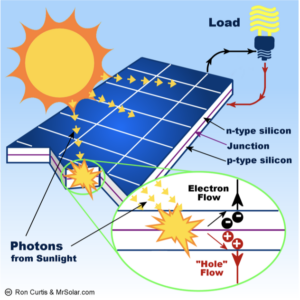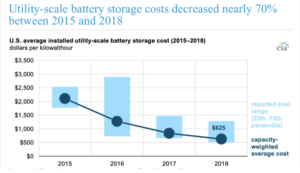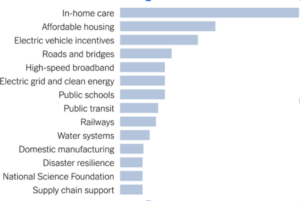< Previous Section (Introduction)
Next Section (Sustainability at Lafayette) >
The Problem Overview:
What Problem is Team FYS Trying to Solve?
Lafayette College has invested in a newly constructed solar array located on top of the Kirby Sports Center. As of now, the Kirby Solar Array only serves to generate energy for the gym. Team Solar FYS worked to solve the following question to extend the functionality of the array: How can Lafayette College shape the Kirby Solar Array into an engaging educational and community driven facility? (Lafayette College, 2021)

Figure 1: “The Kirby Solar Array” (Lafayette College, 2021)
Solar Technology:
Solar energy usage can be traced back as far as 7th century B.C. when humans used sunlight to start fires using magnifying glass materials. This early tinkering was the foundation that led to the development of solar panels. While difficult to credit a singular inventor for the solar panel, the most widely credited are Daryl Chapin, Calvin Fuller, and Gerald Pearson’s creation of the silicon photovoltaic (PV) cell at Bell Labs in 1954. Many argue that this event marks the true invention of PV technology because it was the first instance of a solar technology that could power an electric device for several hours of a day at four percent efficiency, a mere fraction of modern-day panels. (Richardson, L, 2018)

Figure 2: “Dissecting Photovoltaic Technology”, (Online Solar, LLC, 2021)
Today, two main categories of technology are used in solar energy production. The first technology is concentrating solar-thermal power. The second technology is photovoltaics, which is generally used more widely, and what is used in the solar array on Lafayette’s campus. The PV cells within the array absorb the energy from the electromagnetic radiation that shines onto the panel from the sun’s rays. A semiconductor absorbs the radiation and transfers the energy to electrons before the PV cell ultimately absorbs the converted electrical current. Due to its relative expense, silicon is the most common semiconductor among industry PV cells today. There are also several different factors that contribute to a solar panel’s capacity to convert sunlight into electricity including shade, heat, dirt, temperature, and reflection. Because solar panels only have the capacity to store so much energy, and the sun only shines for so many hours in a day, battery storage plays an important role in the efficiency of PV panels. In fact, historically high costing battery storage have limited the expansion of solar and other renewable energies. In recent years, however, the cost for battery storage has rapidly declined. The U.S Energy Information Administration states that “the average energy capacity cost of utility-scale battery storage in the United States has rapidly decreased from $2,152 per kilowatt hour (kWh) in 2015 to $625/kWh in 2018.” With the reduction in battery storage costs, solar has become more affordable and feasible than in the past. (Hoff & Mey, 2020)

Figure 3: “Solar Battery Cost Reduction from 2015-2018”, (Hoff & Mey, 2020)
Momentum Behind Sustainability:
Policy is a predominant dimension that provides rationalization for the construction for the Kirby Solar Array. Environmental and sustainable policy is deeply rooted in the complexity of factors that exploit Earth’s resources, deteriorating the world’s environmental health. According to Harvard Business School, the tragedy of the commons is an economic theory that states, “individuals with access to a shared resource (also called a common) act in their own interest and, in doing so, ultimately deplete the resource” (Spiliakos, 2019). These actions can result in overfishing, the ruining of forests and ecosystems, and overhunting of species. In addition to depletion, the tragedy of the commons can be applied to pollution, putting in chemicals, heat, radioactivity, waste, etc. into the environment. While engineers are often eager to implement a technological fix, climate change cannot be simply resolved through the implementation of more technology, which often contributes to the pollution we observe. Garret Hardon states “the pollution problem has no technical solution; it requires a fundamental extension in morality.” Even so, a “fundamental extension in morality” is a nearly impossible solution for a problem that requires immediate action. For this very reason, policy makers work to create strategies that start to address the extensive and elaborate problem, holding individuals and corporations accountable. Policy is a tool that leaders use to integrate technology and society to undertake potential solutions which address the Tragedy of the Commons and lack of accountability for Earth’s precious resources. Historical policies relating to environmental sustainability are greatly influential to Lafayette’s journey towards institutional sustainability. (Hardin, 1968, 1243-1245)
On a global scale, there are current and historical policies that attempt to address the issue of sustainability and climate change. It is a topic that has become widely politicized, yet one where societal collaboration is vital. Responsibility for reducing harmful toxins to our climate, increasing our use of renewable energy, and educating younger generations stretch from our individual communities and lifestyle to the leadership of entire nations and political leaders. In a global sense, collaboration towards addressing climate change can be seen through the Paris Climate Agreement. Taking place in 2016, the Paris Climate Agreement was signed by a multitude of participating nations with the goal of reducing global warming to below two degrees Celsius relative to the temperatures before the industrial revolution. Renewable energy sources, specifically wind and solar, play a major role in the quest to mitigate global warming to below the two-degree Celsius threshold. The agreement not only represents the need for worldwide collaboration towards reducing global warming, but also the desire and necessity to make meaningful changes now. The ever-increasing effects of climate change urgency provide necessary context for why sustainable solutions and policy have quickly become important for the Earth’s future.
Momentum towards clean and renewable energy is also at the national level, most recently, through President Biden’s infrastructure plan. President Biden’s $2.3 trillion infrastructure plan explicitly states the goal of producing all energy 100% emission free by 2035. In addition to increased use in wind and solar energy, the plan would also retool U.S. manufacturing to build zero emission transportation infrastructure like zero emission vehicle fueling and charging stations. The plan proposes initiatives in a variety of different areas, but those tackling climate change have quite a high priority and monetary designation. (Trabish, H. K).

Figure 4: “Monetary Breakdown of President Biden’s Infrastructure Plan”, (Tankersley, 2021)
Electric vehicle incentives and electric grid and clean energy are both among the higher designations among Biden’s plans. As The New York Times writes, “Mr. Biden’s pledge to tackle climate change is embedded throughout the plan. Roads, bridges, and airports would be made more resilient to the effects of more extreme storms, floods and fires wrought by a warming planet. Spending on research and development could help spur breakthroughs in cutting-edge clean technology, while plans to retrofit and weatherize millions of buildings would make them more energy efficient.” While supporters of different political parties may debate over the economics behind the plan, there is general agreement over the necessity for sustainable solutions poised to protect society from the irreversible damage associated with climate change. (Tankersley, J, n.d.)
Sustainability and Education:
Actions from colleges and universities around the country also mirror the political movement towards a more sustainable future. Lafayette works in collaboration with the Association for the Advancement of Sustainability in Higher Education (AASHE), an interest group dedicated to bringing sustainability efforts to college campuses and universities around the country. AASHE was officially founded in December of 2005, serving as the first professional higher education association for the campus sustainability community in North America. On their website, AASHE states a clear and concise mission statement: “To inspire and catalyze higher education to lead the global sustainability transformation.” Evidently, AASHE views higher education programs as potential leaders and catalysts for greater sustainability transformation. Moreover, their visions involve establishing sustainability efforts on college campuses to be a foundation for a thriving, equitable and ecologically healthy world. (Association for the Advancement of Sustainability in Higher Education, n,d,)
AASHE outlines four distinct strategic goals to achieve their aspirations. Their first of these goals is to “empower members to be transformational leaders for sustainability by providing indispensable resources and outstanding professional development.” To achieve this goal, they lay out the following plan:
- Develop new and improve existing resources, tools and publications
- Strengthen the annual conference and expo to be the marquee forum for all stakeholders within the higher education sustainability community
- Offer high-value professional development programs
- Expand opportunities for networking and building community
Their second goal is to “catalyze sustainability action and innovation through STARS.” AASHE created STARS (Sustainability Tracking, Assessment, and Reporting System) as a method of monitoring and improving sustainability efforts on college campuses. The STARS system measures sustainability metrics through several different sectors, including academics, engagement, operations, planning & administration, and innovation & leadership. Within each sector, there are several different areas, each with criteria that makes up a grander score. For example, within the operations sector, there are nine different areas: air & climate, buildings, energy, food & dining, grounds, purchasing, transportation, waste, and water. Then within just the air & climate sub-sector, there are scores related to a college or university’s emissions inventory and disclosure, as well as their greenhouse gas emissions. STARS is quite a powerful tool and to achieve their second goal, they outline the following plan related to the use of STARS:
- Simplify reporting requirements and reduce barriers to participation in STARS
- Strengthen the value of a STARS rating
- Improve the quality of STARS data
- Increase net income for STARS
The third goal AASHE lists to achieve their larger aspirations is to “accelerate higher education’s contributions to global sustainability through increased outreach, communications and advocacy.” This goal is probably the most conceptual among the first three, in the sense that there are no clear-cut steps towards achieving it. Regardless, it reflects the desire to implement policies and support for sustainability among higher education institutions, and the belief that said institutions have the potential to be quite impactful in nationwide sustainability efforts. Their plan for this goal is as follows:
- Advocate for policies that advance sustainability in higher education
- Champion the value of sustainability in higher education and increase support for sustainability in academics, engagement, operations and administration
- Identify new, high impact strategies to best advance our mission
Lastly, AASHE hopes to “enhance organizational capacity & resilience.” This goal is centered around internal improvement among AASHE. The plan to achieve their goal is as follows:
- Grow the AASHE member community
- Optimize internal efficiency and improve customer experience
- Strengthen organization leadership and governance
- Create a culture that supports employee well-being and motivation
- Ensure AASHE’s financial health and stability
The goals and ambitions of AASHE provide context towards the importance of sustainability movements on higher education institutions across the country. Using the STARS system, AASHE can monitor and track several areas in which sustainability efforts can be implemented into college campuses. AASHE and their corresponding STARS system illustrate the many different areas within a college campus that can involve aspects of sustainability. (Association for the Advancement of Sustainability in Higher Education, n,d,)